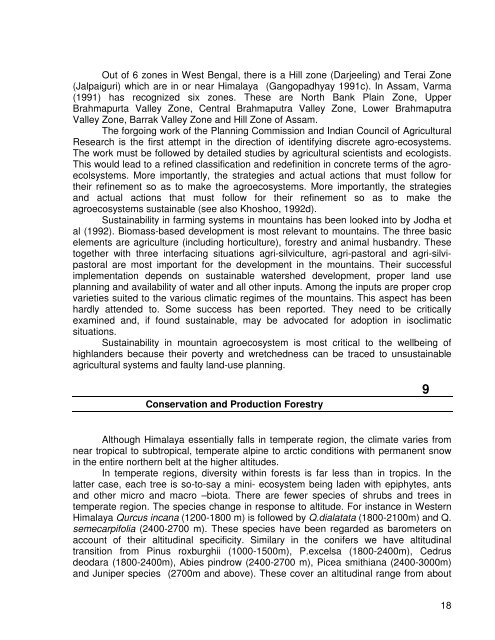Pandit Govind Ballabh Pant Memorial Lecture: II
Pandit Govind Ballabh Pant Memorial Lecture: II
Pandit Govind Ballabh Pant Memorial Lecture: II
You also want an ePaper? Increase the reach of your titles
YUMPU automatically turns print PDFs into web optimized ePapers that Google loves.
Out of 6 zones in West Bengal, there is a Hill zone (Darjeeling) and Terai Zone<br />
(Jalpaiguri) which are in or near Himalaya (Gangopadhyay 1991c). In Assam, Varma<br />
(1991) has recognized six zones. These are North Bank Plain Zone, Upper<br />
Brahmapurta Valley Zone, Central Brahmaputra Valley Zone, Lower Brahmaputra<br />
Valley Zone, Barrak Valley Zone and Hill Zone of Assam.<br />
The forgoing work of the Planning Commission and Indian Council of Agricultural<br />
Research is the first attempt in the direction of identifying discrete agro-ecosystems.<br />
The work must be followed by detailed studies by agricultural scientists and ecologists.<br />
This would lead to a refined classification and redefinition in concrete terms of the agroecolsystems.<br />
More importantly, the strategies and actual actions that must follow for<br />
their refinement so as to make the agroecosystems. More importantly, the strategies<br />
and actual actions that must follow for their refinement so as to make the<br />
agroecosystems sustainable (see also Khoshoo, 1992d).<br />
Sustainability in farming systems in mountains has been looked into by Jodha et<br />
al (1992). Biomass-based development is most relevant to mountains. The three basic<br />
elements are agriculture (including horticulture), forestry and animal husbandry. These<br />
together with three interfacing situations agri-silviculture, agri-pastoral and agri-silvipastoral<br />
are most important for the development in the mountains. Their successful<br />
implementation depends on sustainable watershed development, proper land use<br />
planning and availability of water and all other inputs. Among the inputs are proper crop<br />
varieties suited to the various climatic regimes of the mountains. This aspect has been<br />
hardly attended to. Some success has been reported. They need to be critically<br />
examined and, if found sustainable, may be advocated for adoption in isoclimatic<br />
situations.<br />
Sustainability in mountain agroecosystem is most critical to the wellbeing of<br />
highlanders because their poverty and wretchedness can be traced to unsustainable<br />
agricultural systems and faulty land-use planning.<br />
Conservation and Production Forestry<br />
9<br />
Although Himalaya essentially falls in temperate region, the climate varies from<br />
near tropical to subtropical, temperate alpine to arctic conditions with permanent snow<br />
in the entire northern belt at the higher altitudes.<br />
In temperate regions, diversity within forests is far less than in tropics. In the<br />
latter case, each tree is so-to-say a mini- ecosystem being laden with epiphytes, ants<br />
and other micro and macro –biota. There are fewer species of shrubs and trees in<br />
temperate region. The species change in response to altitude. For instance in Western<br />
Himalaya Qurcus incana (1200-1800 m) is followed by Q.dialatata (1800-2100m) and Q.<br />
semecarpifolia (2400-2700 m). These species have been regarded as barometers on<br />
account of their altitudinal specificity. Similary in the conifers we have altitudinal<br />
transition from Pinus roxburghii (1000-1500m), P.excelsa (1800-2400m), Cedrus<br />
deodara (1800-2400m), Abies pindrow (2400-2700 m), Picea smithiana (2400-3000m)<br />
and Juniper species (2700m and above). These cover an altitudinal range from about<br />
18











